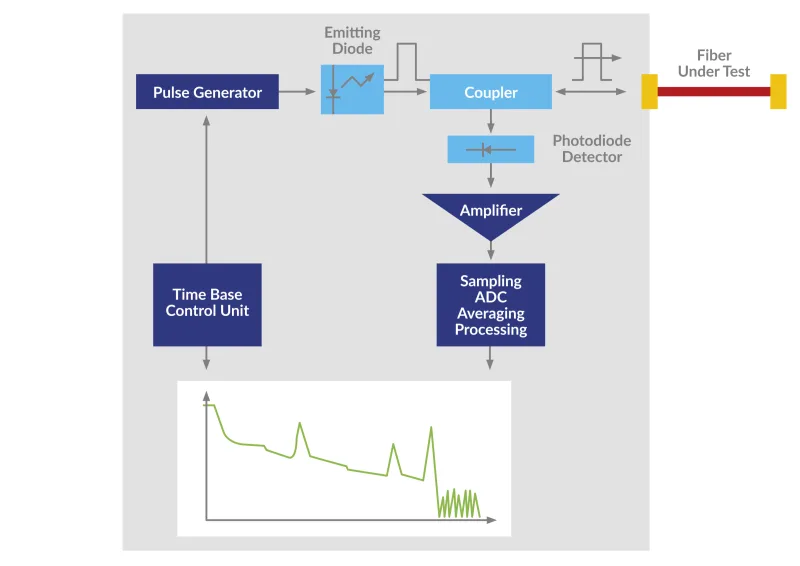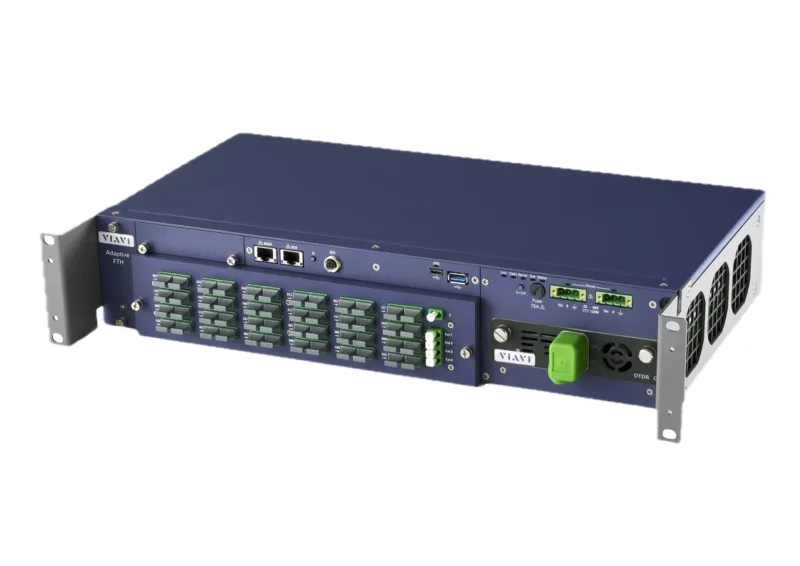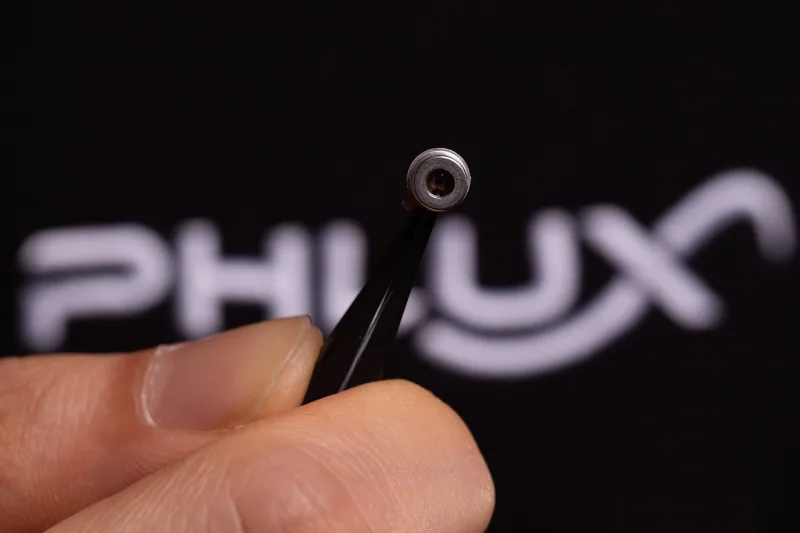Optical Networks Get 24/7 Health Check with Real-Time OTDR Technology
Telecommunications companies are increasingly turning to real-time, integrated Optical Time Domain Reflectometers (OTDRs) for round-the-clock performance monitoring. This article looks at the role of real-time OTDRs and how they differ from the hand-held devices used by field technicians.
Understanding OTDR Technology
OTDRs are sophisticated instruments used to characterise optical fibres. They work by sending short laser pulses down a fibre and measuring the light reflected or scattered back from various points along its length. This allows OTDRs to determine key performance metrics such as end-to-end distance, signal attenuation, and the location of events like connectors, splices, or faults.
The technology behind OTDRs is based on the principles of backscattered light and Fresnel reflections. When a pulse of light is sent through a fibre, a small portion of that light is scattered back towards the source due to imperfections and inherent properties of the fibre. By analysing this backscattered light, OTDRs can create a detailed trace that reveals the fibre's characteristics.

Block diagram of a typical OTDR (Graphic: VIAVI)
The precision of OTDR measurements is crucial for effective network management. Modern OTDRs can detect events with a resolution of less than a metre, allowing for pinpoint accuracy in fault location. This level of precision is particularly important in dense urban environments where fibre networks can be complex and tightly packed.
From Handheld to Integrated: Complementary OTDR Technologies
OTDR testing in the field is commonly performed using handheld devices, requiring technicians to physically connect to fibres at various points in the network. These portable OTDRs are typically lightweight, battery-powered, and optimised for ease of use by field technicians.
Handheld OTDRs have been the workhorses of fibre optic testing for decades. They offer flexibility and are particularly useful for field testing, troubleshooting, and network installation. However, they require manual operation and can only provide snapshots of network health at specific times.
A complementary technology, real-time or line-card OTDRs, can be integrated directly into network equipment or installed as standalone units in central offices. These provide continuous monitoring of fibre health without the need for manual intervention.
The Importance of Wavelength Selection in OTDR Testing
A critical aspect of OTDR technology is the choice of test wavelengths. This selection significantly impacts the effectiveness and practicality of fibre monitoring, especially in live networks.
Traditionally, handheld OTDRs operate at standard telecommunication wavelengths:
- 850 nm and 1300 nm for multimode fibre
- 1310 nm and 1550 nm for single-mode fibre
These wavelengths are chosen because they align with the typical operating wavelengths of fibre optic communication systems, providing accurate representations of the network's performance under normal conditions.
However, real-time, integrated OTDRs face a unique challenge: they must operate without interfering with active data transmission. To address this, some embedded systems use a wavelength of 1625 nm or 1650 nm for testing. These wavelengths fall outside the typical communication bands, allowing for in-service testing without disrupting network traffic.
The choice of 1625 nm or 1650 nm offers several advantages:
- Minimal interference: These wavelengths are sufficiently separated from the main communication bands (around 1310 nm and 1550 nm) to avoid interference.
- Sensitivity to bends and stresses: Longer wavelengths are more sensitive to fibre bends and stresses, making them excellent for detecting physical disturbances in the fibre.
- Compatibility with wavelength-division multiplexing (WDM) systems: Many modern networks use WDM to transmit multiple signals on a single fibre. The 1625 nm or 1650 nm test signals can be easily multiplexed with existing traffic.
However, the use of these wavelengths also presents some challenges:
- Higher attenuation: Light at 1625 nm or 1650 nm experiences slightly higher attenuation in typical silica fibres compared to 1550 nm, potentially limiting the testing range.
- Specialised equipment: Network elements must be capable of passing or filtering these wavelengths appropriately, which may require upgrades to existing infrastructure.
- Calibration considerations: The behaviour of fibre at these wavelengths may differ slightly from the main communication wavelengths, requiring careful interpretation of results.
Some advanced real-time OTDR systems are capable of testing at multiple wavelengths, including the standard communication wavelengths. This multi-wavelength approach can provide a more comprehensive picture of fibre health, but it typically requires the network to be taken offline during testing.
The choice of test wavelength in real-time OTDRs represents a careful balance between non-intrusiveness, sensitivity, and practicality. As fibre optic technology continues to evolve, we may see the development of new wavelengths and techniques that further optimise this balance, enhancing our ability to monitor and maintain these critical networks.
Advantages of Real-Time Integrated OTDRs
Real-time OTDRs offer several benefits:
- Real-time fault detection: These systems can immediately begin the fault location process when a hard failure occurs, significantly reducing response times.
- Proactive maintenance: By creating regular profiles of fibres over time, degradations can be detected and addressed before they become service-affecting.
- Reduced operational costs: Continuous monitoring can eliminate the need for multiple truck rolls and erroneous dispatches.
- Enhanced network reliability: Prompt detection and resolution of issues such as signal attenuation and component failures improve overall network stability.
- Security monitoring: Some systems can detect and locate potential fibre tapping, enhancing network security.
The ability to perform in-service testing is particularly valuable for high-capacity networks where downtime can be extremely costly. By using out-of-band wavelengths, real-time OTDRs can continuously monitor fibre health without affecting data transmission, ensuring uninterrupted service for end-users.

A modular rack mounted OTDR for continuous network monitoring
These systems typically integrate with network management platforms, providing alerts and reports on fibre health. This integration allows network operators to have a comprehensive view of their infrastructure's performance and quickly respond to any issues.
The adoption of real-time OTDR technology is not limited to large telecom operators. Smaller regional providers and enterprise networks are also seeing the value in continuous fibre monitoring. As the technology becomes more accessible and cost-effective, it's well on the way to becoming a standard feature in fibre optic networks of all sizes.
The Role of AI and Machine Learning in OTDRs
As OTDR technology advances, artificial intelligence and machine learning are playing an increasingly important role. These technologies are being used to analyse OTDR traces and automatically detect and classify events.
For example, researchers have developed deep neural networks capable of automatically detecting events in OTDR traces. These models can estimate the location and type of each event, providing a more efficient and accurate analysis of fibre health.
AI-powered systems can also predict potential failures by analysing historical data and identifying patterns that precede fibre degradation. This predictive maintenance approach can significantly reduce network downtime and extend the lifespan of fibre optic infrastructure.
How A New Sensor Technology is Impacting OTDR Performance
OTDR infrared sensors operating between 1000 nm and 1650 nm are usually based on Indium Gallium Arsenide (InGaAs) avalanche photodiodes (APDs), a type of semiconductor device. The sensitivity of these devices is limited by the dark noise created by the diode’s operation, specifically its avalanche process.
Recent developments in InGaAs APDs resulting from the introduction of antimony alloys in the compound semiconductor manufacturing process, has resulted in sensors 12X greater sensitivity compared to traditional components. This increased sensitivity allows for detection of weaker return signals and up to 50% greater operating range for OTDRs for a given laser power, or the ability to use lower laser power while maintaining range.
The new class of devices, called Noiseless InGaAs® APDs also exhibit faster overload recovery, which reduces 'dead zones' where faults might be missed due to sensor unresponsiveness after exposure to strong reflections. They also demonstrate lower temperature drift and stable high-temperature performance, ensuring consistent accuracy across various environmental conditions. The improved performance of these sensors also enables the detection of more events and smaller event impacts along the optical cable.

Future Trends in Real-Time OTDR
Looking to the future, industry experts predict further advancements in this field. There's a growing trend towards integrating OTDR functionality directly into optical transceivers, which could make continuous fibre monitoring a standard feature in next-generation network equipment.
Additionally, as the Internet of Things (IoT) grows, the demand for reliable, high-speed connectivity is increasing. Real-time OTDR technology will play a crucial role in ensuring the integrity and performance of the fibre optic infrastructure supporting these IoT networks.
The development of more compact and energy-efficient OTDR modules is another area of focus. This could lead to the integration of OTDR functionality into a wider range of network devices, further expanding the reach of continuous fibre monitoring.
Conclusion
As optical networks continue to expand, supporting everything from 5G cellular networks to high-speed internet and critical infrastructure, the importance of maintaining fibre health has never been greater. Real-time OTDR technology offers a powerful tool for ensuring the integrity and performance of these vital communication arteries.
While handheld OTDRs will likely remain an important tool for field technicians, the growth of continuous monitoring reflects the need for real-time, comprehensive network health management to pave the way for more resilient, efficient, and secure communication infrastructure in the years to come.